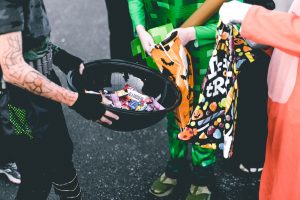Every Halloween I take a trip down memory lane, but probably not in the way you might expect. Sure, I remember my favorite costumes as a child (it was Jasmine, from Aladdin), the time my husband and I tied our legs together for an entire evening in our commitment to the costume of “three-legged race champions”, and my more recent adventures of Halloween as a mother of young children. Another thing I remember? The first time I read about the Candy Witch. That is what I want to tell you about today.
![]()
You say you’ve never heard of the Candy Witch? That’s a problem that I’m about to fix. Keep reading.
Starting with my Master’s thesis, continuing through my dissertation and into today, one of the fundamental questions that I’m particularly interested in researching is why we believe the things we do. This question, about how children develop an understanding of what is real or pretend, is of ongoing interest in the world of developmental psychology. For example, most children will believe that germs are real, without having ever seen one. Why? And what makes beliefs about germs any different from beliefs about Santa Claus? The tooth fairy? Or even God?
 Some of the answers to this question about belief comes down to cultural supports. Children don’t think of concepts of germs, Santa, or God on their own. (Actually, there is some really interesting research suggesting that children may be predisposed to belief in a being like God, even without the cultural supports I’m about to describe…but that’s a topic for a future blog.) Rather, children come to believe these concepts because of the constant cultural discourse around these concepts. Take my own home, as an example. The one picture I have hanging up in our bathroom instructs my children to “wash your hands and say your prayers because germs and Jesus are everywhere.” These are the kinds of cultural supports—echoed in our daily conversations and activities—that may prompt children’s belief in these otherwise unobservable entities.
Some of the answers to this question about belief comes down to cultural supports. Children don’t think of concepts of germs, Santa, or God on their own. (Actually, there is some really interesting research suggesting that children may be predisposed to belief in a being like God, even without the cultural supports I’m about to describe…but that’s a topic for a future blog.) Rather, children come to believe these concepts because of the constant cultural discourse around these concepts. Take my own home, as an example. The one picture I have hanging up in our bathroom instructs my children to “wash your hands and say your prayers because germs and Jesus are everywhere.” These are the kinds of cultural supports—echoed in our daily conversations and activities—that may prompt children’s belief in these otherwise unobservable entities.
However, a problem that developmental psychologists face is that we can’t experimentally control children’s exposure to discourse around germs, Santa, or God. We can merely look for correlations between exposure and belief. This is a problem some creative researchers set out to address.
Enter: The Candy Witch.
Woolley, Boerger, and Markman published a paper in 2004 in which preschool-aged children were introduced to the Candy Witch at their daycare, about a week before Halloween. Their research question centered on how exposure and cultural supports for a novel fantastical being would predict children’s subsequent belief in the actual existence of that being. In other words, what would be required to get children to believe that something they couldn’t see firsthand, but that other people talked about as real, was indeed real?
To start, the researchers measured what children knew about Halloween and what they typically did. Then, importantly, they were introduced to the Candy Witch. Children were told that the Candy Witch was a nice witch who would visit houses the night after Halloween and take the trick-or-treat candy they had collected, leaving behind a new toy. After this story, some of these children’s parents also read a story about the Candy Witch to them at home. (Think about it, when children hear about germs, it’s from lots of people, not just someone at school.) The idea was that the more exposure, the more likely children would be to believe that the Candy Witch was real. Finally, some of these children then had their candy actually taken after trick-or-treating, with a toy left instead. (Sneaky parents!)
So, what happened? Did children believe in the Candy Witch? (Pause, make your predictions.)
 The answer? It depends. Some kids—but not all—did believe that the Candy Witch existed when asked after Halloween. The kids who were the most likely to believe in the Candy Witch were older (e.g., 5 years old, rather than 4 years old). The older kids who had received a visit from the Candy Witch were the most likely to believe. Interestingly, a visit by the Candy Witch didn’t seem to convince the younger children to believe any more than the younger children who were not visited. It’s possible that the older children were better able to piece together the clues about the existence of the Candy Witch (e.g., the stories, the disappearing candy, the new toy) than the younger children were.
The answer? It depends. Some kids—but not all—did believe that the Candy Witch existed when asked after Halloween. The kids who were the most likely to believe in the Candy Witch were older (e.g., 5 years old, rather than 4 years old). The older kids who had received a visit from the Candy Witch were the most likely to believe. Interestingly, a visit by the Candy Witch didn’t seem to convince the younger children to believe any more than the younger children who were not visited. It’s possible that the older children were better able to piece together the clues about the existence of the Candy Witch (e.g., the stories, the disappearing candy, the new toy) than the younger children were.
Another important factor in belief was the overall number of other fantastical beings the children believed existed. Children who believed that the Candy Witch was real were also more likely to believe that Santa and the Easter Bunny were real. It’s possible that these other cultural figures served as a starting point for belief in this novel character.
This is one of my favorite studies in developmental psychology. There are so many details I haven’t described here. For example, the researchers accounted for things like preference for toys versus candy and general fantasy orientation of the children. They measured children’s beliefs about the qualities of these fantastical beings, including the Candy Witch (e.g., could she eat dinner? Get her feelings hurt?). They asked parents questions about their encouragement of belief in the Candy Witch. And (most impressively), they followed up with these families a year later to measure how much the children remembered and whether they still believed in the Candy Witch (without ongoing cultural support for that belief). So many interesting bits!
On this eve of Halloween, I would invite you to create a new Halloween memory. Join me in the gleeful remembering of really awesome research. You can read the full article here.
When you were a kid, would you have wanted to be visited by the Candy Witch? Leave your comments below!
—

Dr. Erin I. Smith
Associate Professor of Psychology
Director of Research, Center for the Study of Human Behavior
 Here in this blog you will see snapshots of some of the research conducted through the CSHB. You will also hear stories of researchers bringing their identities as scientists and Christians together in the research process. You will read about innovative research happening across the globe and have an opportunity to engage in conversations about the implications. You may even find that you want to author a blog post to share about your own research, research you have read about, or your personal journey as a researcher. (Look for a future blog post for details on how to become a CSHB blog contributor!)
Here in this blog you will see snapshots of some of the research conducted through the CSHB. You will also hear stories of researchers bringing their identities as scientists and Christians together in the research process. You will read about innovative research happening across the globe and have an opportunity to engage in conversations about the implications. You may even find that you want to author a blog post to share about your own research, research you have read about, or your personal journey as a researcher. (Look for a future blog post for details on how to become a CSHB blog contributor!)